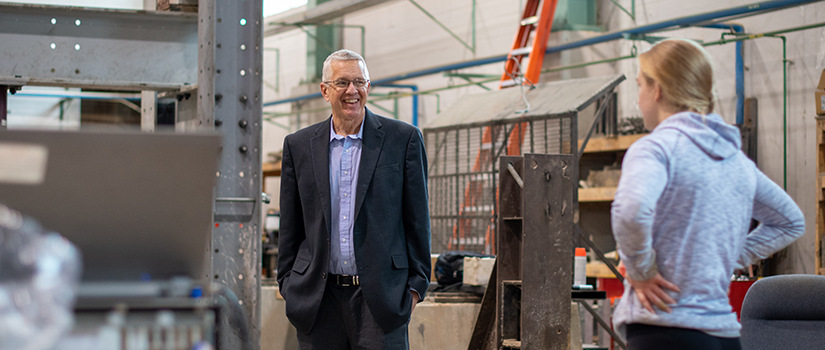In South Carolina, over 1,000 of the state’s 8500 bridges are load restricted, reducing the weight of vehicles that can pass over them. In some cases, trucks can be forced to detour to avoid these bridges — affecting the state’s commerce — and during emergencies, fire trucks and other vehicles may not be able to take the most direct route in response. Additionally, millions of dollars are spent each year strengthening these load-restricted bridges, without truly knowing the weight of loads that cross them or the bridges’ responses to these loads.
Selecting which bridges get rated with restrictions is a tried-and-true process, but it does not take advantage of new and developing technologies. Paul Ziehl, the UofSC College of Engineering and Computing’s associate dean for research, believes it is time for this process to change.
Through a grant from the U.S. Department of Transportation (DOT) and the Center for Connected Multimodal Mobility, and alongside two ongoing projects with the South Carolina DOT, Ziehl is developing a more accurate way to remotely assess the load-carrying capacity of South Carolina’s bridges. Using sensors and artificial intelligence, he is creating a digital twin system that will increase the safety of the state’s bridges and potentially save taxpayers millions of dollars by avoiding unnecessary bridge repairs.
“Some of the bridges in the rural parts of South Carolina — and there’s a lot of them, over 1,000 — are load restricted and emergency equipment, including fire trucks, are not allowed to cross,” Ziehl says. “In some cases, it is difficult to get a school bus across. However, some of these bridges may have adequate capacity and these vehicles may be able to safely get across, but current calculations show otherwise.”
Currently, load restrictions are calculated based on drawings of bridges which may or may not be accurate. Then, to compensate for factors that cannot be seen — like bridge degradation and load — the engineers conducting these assessments have to use assumptions in their calculations.
While effective, Ziehl says the approach is not as efficient or accurate as it could be. In fact, this approach generally leads to conservative assessments of a bridge’s load-carrying capacity and potentially leads to unnecessary bridge restrictions.
“The bets in these assessments are hedged on the capacity of the bridge and the same thing is done on the load side of the equation,” he says. “On the load side, you don’t know how many logging trucks are going across, or how many overloaded vehicles are going across. You don’t know much of anything on the loading side, because it is costly to monitor.”
Ziehl believes that using a digital twin could help to answer these unknowns. A digital twin is a calibrated numerical model of a bridge that has the benefit of incorporating its load and structural response. He believes that as sensors become more prevalent in self-driving cars and trucks, the digital twin approach will allow for a better understanding of the loading on bridges and also their responses to loads, which will decrease the number of restricted bridges without compromising safety. The approach will ensure money is not spent strengthening bridges that are already sufficient and will focus repair efforts on the bridges in South Carolina that actually need them.
“My sense is that with all the inherent unknowns in this process, we are making assumptions that are generally conservative,” he says. “Due to the uncertainties in loads and bridges’ responses to those loads, strengthening solutions are potentially more expensive than they need to be.”
Currently, Ziehl is working with Gurcan Comert, a professor at Benedict College and an investigator on the project, to demonstrate the effectiveness of the technology on one bridge in Abbeville, South Carolina. Following an effective demonstration, their goal is for Structural Monitoring Solutions, an industrial partner on the project, to commercialize the technology so it can be applied across the state.
“Dr. Ziehl is unique,” says Terry Tamutus, the founder and CEO of Structural Monitoring Solutions. “Many professors will just try to do research for the sake of research, but Paul will develop working practical technologies for bridges, so it actually benefits the world.”
In South Carolina, Ziehl’s research could be transformative.
“We certainly welcome the expanded use of technology to provide a much more complete documentation of the structural response and practical capacity of bridges,” says Mark Hunter, a state bridge maintenance engineer at the South Carolina Department of Transportation. “Also, we are in total agreement that Dr. Ziehl is the perfect person to determine applications as he is well versed and experienced with our more vulnerable bridge types in South Carolina. He is currently introducing practical and economical designs to improve bridge capacity.”
